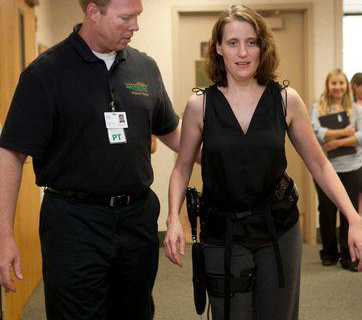
Kirk Randall, a physical therapist, helps Lisa Curtis walk without her walking sticks with her new Kickstart Kinetic Device at Mary Free Bed Hospital on Friday, July 19, 2013. Curtis, who has multiple sclerosis, is the first person in Michigan to receive the device. (Lauren Petracca | MLive.com)
GRAND RAPIDS, MI – After five years of struggling to walk because of the effects of multiple sclerosis, Lisa Curtis stepped out Friday, July 19, with a spring in her step.
The spring – a real metal spring – was part of a new device developed to help people regain mobility. The Kickstart Kinetic Device was introduced last fall by Seattle-based Cadence Biomedical.
Curtis, a 40-year-old teacher from Portage, became the first person in Michigan to be fitted with a Kickstart on Friday at Mary Free Bed Rehabilitation Hospital. Holding two trekking poles for balance, she walked down the hall of the hospital.
The result was exciting, she said. And awkward. She laughed as she explained that she is used to walking with small, tentative steps. With Kickstart, she was able to take full steps.
"It's normal, and I'm not used to normal anymore," she said.
Ultimately, she hopes the device will help her develop the strength to walk more easily and quickly and to keep up with her children, 8-year-old Christopher and 4-year-old Samantha.
"I am hoping I will be able to get rid of my sticks and be able to walk normally," she said. "I'd like to be able to walk right out of this device."
The mechanical device, which uses no batteries, was inspired by the long tendons in horses' legs that enable horses to run much faster and more efficiently than humans. It is designed to help those with walking impairments caused by strokes, brain or spinal cord injuries, amyotrophic lateral sclerosis, M.S. and other conditions.
Curtis was fitted with Kickstart on her right leg, because the weak hamstring muscle and hip flexor make it difficult for her to walk. The brace-like device has pulleys at the ankle and hip that are connected to a spring.
When Curtis stepped forward with her left leg, the spring stretched out. As she started to move the right leg, the stored energy in the spring helped the right leg to swing forward. The device can be adjusted to provide varying amounts of assistance.
Curtis became the first in the state to use Kickstart thanks to research efforts by from her husband, Jim Curtis, a pharmacist at Bronson Methodist Hospital in Kalamazoo. He read about the device created by Cadence Biomedical, a company formed in 2007 with the goal of creating affordable prosthetics that people could use at home.
He brought it the attention of specialists at Mary Free Bed, where Curtis has received therapy to improve her gait.
With a robotic device called a Lokomat, she has made progress and built strength. Therapists identified the weakness in her right hip flexor and the back of the leg.
Although she also can do exercises to strengthen those areas, Kickstart has the advantage of building the muscles in a functional way, said physical therapist Kirk Randall.
"I'm totally excited for her," said Patrick Dorgan, an orthotist who helped fit her with the device. "She is a perfect candidate for it."
Curtis was 29 years old and just starting her career as a kindergarten and first-grade teacher when she was diagnosed with M.S. in 2002.
In a clinical trial in Chicago, she underwent a stem-cell transplant in 2010. Since then, the disease progression has stopped and many of her symptoms have improved or disappeared. She no longer has numbness in her hands or blurred vision in her right eye, and she has less numbness in her legs.
She hopes Kickstart will help her build back the strength in her right leg and help her to re-learn how to walk with a normal gait.
"It's very hard work when you have a gait problem to correct it, especially when it involves the hip and the back of the leg," her husband said. "The nice thing about this is it's something she can work with at home."
Chie Kawahara, an engineer and a vice president of Cadence, came to Mary Free Bed to work with orthotists in fitting the device.
The Kickstart was attached to Curtis' pink tennis shoe with a foot plate and connected to her leg with Velcro straps. A padded belt was worn around her waist.
With better mobility, Curtis said she hopes someday to return to her job as a teacher, which she quit nine years ago as her M.S. symptoms worsened.
For now, she is looking forward to saying to her husband, "Let's go for a walk."
As she walked down the hall, taking bigger steps than she has in years, Curtis was all smiles.
"It's exciting," she said.



